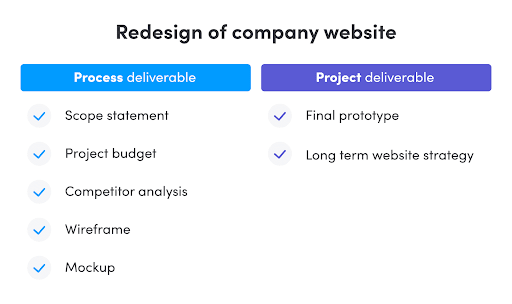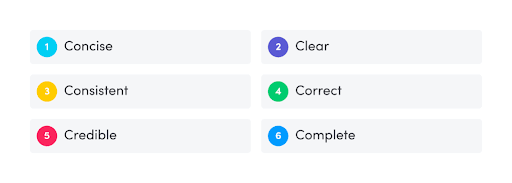수많은 프로젝트 관리 및 프로젝트 결과물. 그리고 (너무나도) 부족한 시간.
프로젝트와 그에 따른 프로젝트 관리 및 프로젝트 결과물의 수는 계속 증가하고 있지만 하루는 여전히 24시간뿐입니다.
전 세계의 프로젝트 관리자들은 점점 더 많은 업무를 담당하고 있으며 이러한 과부하는 프로젝트 관리에 부정적인 영향을 미칠 수 있습니다.
여러 프로젝트를 동시에 수행하면서 작업 일정 이해관계자 그리고 그 사이의 다양한 요소를 조율하는 과정에서 중요한 업무 역할과 책임이 점점 흐려지기 시작합니다.
결국 우리는 인간이니까요.
이런 상황을 피할 수 있을까요?
각 프로젝트에 들이는 모든 노력과 시간이 헛되지 않도록 확실한 프로젝트 관리 및 프로젝트 결과물을 보장하는 방법이 있을까요?
짧은 대답은 단연코 ‘있다’입니다.
이 문제를 해결하는 방법을 살펴보기 전에 먼저 몇 가지 기본 개념을 정의해 보겠습니다.
프로젝트 결과물이란?
간단히 말해, 프로젝트 결과물은 특정 프로젝트를 위해 의도적으로 생성된 모든 형태의 출력물을 의미합니다.
프로젝트 결과물에는 두 가지 주요 유형이 있습니다.
- 프로세스 결과물: 프로젝트의 최종 목표를 달성하는 데 중요한 역할을 합니다.
- 프로젝트 결과물: 프로젝트의 궁극적인 목표입니다.
그러나, 중요한 것은 세부 사항입니다.
프로젝트 결과물은 다양한 형태로 나타날 수 있습니다.
- 유형적이거나 무형적일 수 있습니다.
- 내부용 또는 외부용일 수 있습니다.
- 보고서, 제품, 소프트웨어 등 다양한 형식으로 존재할 수 있습니다.
이 모든 것은 각 프로젝트의 구체적인 요구 사항에 따라 달라집니다.
프로젝트 결과물 예시
모든 프로젝트 결과물이 동일하게 생성되는 것은 아닙니다.
프로젝트 결과물은 산업, 조직, 프로젝트 유형에 따라 달라질 수 있습니다. 따라서 하나의 표준 리스트를 만드는 것은 현실적으로 어렵습니다. 하지만 공통적으로 나타나는 유형이 있습니다.
예를 들어 많은 사람이 공감할 수 있는 프로젝트를 가정해 보겠습니다.
“회사 웹사이트 리디자인” 프로젝트를 진행할 경우 프로세스 결과물과 프로젝트 결과물은 다음과 같이 나뉠 수 있습니다.

기억하세요. 이 예시는 특정 산업에 한정된 일부 사례에 불과합니다.
프로젝트 관리 및 프로젝트 결과물은 프로젝트가 진행되는 동안 생성된 모든 중요한 작업 결과물을 포함할 수 있습니다.
초기 프로젝트 관리 및 프로젝트 결과물 목록에는 모든 이해관계자와 프로젝트의 모든 단계가 포함되어야 하며 최종 통합 결과까지 고려되어야 합니다.
앞서 설명한 웹사이트 리디자인 사례를 다시 보면 프로젝트 관리 및 프로젝트 결과물은 종종 다른 사람이 특정 작업을 수행하는 것에 의존합니다.
이것을 ‘종속성’이라고 합니다. 일반적으로, 프로젝트의 범위가 클수록, 프로젝트 마일스톤이 많을수록 이러한 작업 종속성도 증가하는 경향이 있습니다.
그렇다면 프로젝트 결과물이 왜 그렇게 중요할까요?
왜 프로젝트 결과물이 프로젝트 관리에서 중요한가요?
프로젝트 관리 및 프로젝트 결과물은 단순히 중요한 것이 아니라 필수적입니다.
복잡한 프로젝트를 관리할 때 여러 이해관계자가 관여하게 되면, 모든 프로젝트 팀원은 최종 프로젝트 목표를 잘 인지하고 있습니다. 또한, 모든 이해관계자는 자신의 역할과 책임을 알고 있습니다.
좋은 소식이죠.
그러나… 프로젝트 마감 기한이 없고, 프로젝트 마일스톤이 없고 진행 상황을 보고할 방법이 없으며 모든 사람이 동일한 목표를 향해 나아가고 있는지 확인할 방법이 없습니다. 그리고 프로젝트 스폰서에게 직접 공유할 내용조차 없습니다.
이런 상황이라면 결과가 나쁠 수밖에 없습니다.
마지막 마감일이 되었을 때 (놀랍게도!) 많은 내부 및 외부 이해관계자가 일정을 맞추지 못하고 있으며 일부는 주요 목표와 정렬되지 않은 상태입니다. 그리고 결정적으로 당신, 즉 프로젝트 관리자이자 리더는 프로젝트의 흐름을 완전히 놓치게 됩니다.
혼돈이 시작됩니다.
“이러한 완전한 무질서를 방지하거나 최소한 완화하기 위해, 프로젝트 관리자는 고품질의 프로젝트 결과물을 철저한 일정에 따라 생산하고 체계적인 승인 프로세스를 구축하는 것이 필수적입니다.
이를 통해 프로젝트의 진행 상황이 특정 KPI들과 일치하도록 보장할 수 있습니다.”
참고: 내부 프로젝트 결과물은 종종 무시되거나 외부 프로젝트 결과물보다 중요하지 않다고 간주됩니다.
잘못된 생각입니다.
너무나도 흔하게 발생하는 치명적인 실수 중 하나는 내부 프로젝트 결과물의 품질에 투자하지 않는 것입니다. 많은 사람들이 내부 프로젝트 결과물을 단순히 “불필요한 관료적 절차”로 간주하고 무시하는 경향이 있습니다.
또 한 번 잘못된 생각입니다.
외부 프로젝트 결과물의 품질은 전적으로 내부 프로젝트 결과물과 이해관계자들이 제공하는 프로젝트 결과물에 달려 있습니다.
앞서 언급한 웹사이트 리디자인 예제로 다시 돌아가 보면 만약 와이어프레임이 미완성 상태로 제출되거나 늦게 제공된다면 이는 프로젝트 전체의 품질에 부정적인 영향을 미치게 됩니다.
모든 내부 및 외부 이해관계자는 고품질의 프로젝트 결과물을 받는 것에 의존하고 있으며 이를 바탕으로 자신의 결과물을 만들어갑니다. 즉, 잘못된 데이터가 들어가면 잘못된 데이터가 나옵니다.
그렇다면 고품질의 프로젝트 결과물은 어떤 모습이어야 할까요?
고품질 프로젝트 결과물을 위한 두 가지 핵심 요소
철저한 준비 + 품질 체크리스트 = 고품질 프로젝트 결과물
핵심 요소 1: 준비
알렉산더 그레이엄 벨은 “무엇보다도 준비가 성공의 열쇠다”라고 말했다고 합니다.
당신이 프로젝트 결과물을 직접 실행하는 역할이 아닐 수도 있지만, 그 품질을 책임지는 위치라면 결국 결과물에 대한 책임을 져야 합니다. 따라서, 이해관계자들과의 킥오프 회의 전에 반드시 준비해야 할 몇 가지 중요한 사항이 있습니다.
- 모든 프로젝트 결과물을 명확하게 정의하세요. 개발 단계에서 결과물을 추가해야 하는 상황이 발생한다면, 프로젝트 범위를 조정해야 할 수도 있습니다. 이는 매우 번거롭고 비효율적일 수 있습니다.
- 각 프로젝트 결과물의 개요를 철저히 작성하세요. 개요가 불명확할수록 이해관계자들과의 의견 조율이 길어지고, 오해와 혼란이 발생할 가능성이 높아집니다.
- 명확한 프로젝트 단계 일정을 만들고 공유하세요. 이를 통해 이해관계자들이 자신의 역할과 전체 프로젝트 내에서의 위치를 쉽게 이해하고 진행 상황을 추적할 수 있습니다.
핵심 요소 2: 품질 체크리스트
일상적인 업무에서 프로젝트 결과물을 제출하고, 요청하고, 검토하는 과정이 반복됩니다. 이러한 과정에서 특정 실수나 누락이 발생하는 것은 당연한 일입니다.
하지만 안타깝게도 이러한 문제들은 저절로 해결되지 않으며 오히려 가장 곤란한 시점에 다시 나타나기 마련입니다.
따라서 프로젝트 관리자로서 모범을 보이고 체계적인 승인 프로세스를 구축하며 이해관계자들에게도 동일한 높은 기준을 요구하는 것이 중요합니다.
최상의 실무 관행을 정착시키고 프로젝트 결과물의 품질을 측정하기 위해 6C 원칙을 적용하세요:

각 항목을 자세히 살펴보면 다음과 같습니다.
- 간결성(Concise): 결과물이 본래 목표에만 집중하고 있는가?
- 명확성(Clear): 결과물이 논리적이고 이해하기 쉬운가? 검토하기에 적절한 구조를 가지고 있는가?
- 일관성(Consistent): 프로젝트 목표와 부합하며, 다른 프로젝트 결과물들과 명확하게 연결되는가?
- 정확성(Correct): 오류가 없는가? 철저하게 검토되었는가?
- 신뢰성(Credible): 필요한 경우 충분한 테스트를 거쳤는가? 신뢰할 수 있는 전문가에 의해 검토되었는가?
- 완결성(Complete): 필요한 모든 사항이 포함되어 있는가? 100% 제출 준비가 완료되었는가?
이 6C 원칙은 프로젝트 결과물이 당신의 손을 거칠 때마다 반드시 확인해야 할 체크리스트로 활용해야 합니다.
경험이 많아질수록 당신의 체크리스트도 더 길어질 것입니다. 따라서 프로젝트의 특성과 업계에 맞게 조정하고 발전시켜 나가는 것이 중요합니다.
하지만 이 체크리스트를 혼자만 사용하는 실수를 범하지 마십시오. 품질 체크리스트는 공유를 위해 만들어진 도구이며 어떤 프로젝트이든 모든 이해관계자가 공유할 수 있도록 명확한 품질 기준을 설정하는 것이 필수적입니다.
이 원칙이 실제로는 어떻게 적용될까요?
미니 사례 연구: Creativeans는 먼데이닷컴을 어떻게 활용하고있나요?
이 모든 이론적인 내용이 실제 현실에서는 어떻게 적용될까요?
Creativeans는 온라인 제품이 아닌 실제 제품의 디자인과 브랜딩을 전문으로 하는 다학제적 디자인 회사입니다. 이 회사는 브랜딩, 제품 디자인, 패키징, 커뮤니케이션 디자인 등 4가지 핵심 분야에 중점을 둡니다.
Creativeans는 프로젝트 초기 단계에서부터 최종 구현 단계까지 고객을 지원합니다. 팀원들은 먼저 제품 디자인을 시작하고, 그다음 패키지 디자인 및 전체 브랜딩 작업으로 확장해 나갑니다. 마지막으로, 마케팅 및 기타 온라인 수단을 활용하여 커뮤니케이션 전략을 구축합니다. 이처럼 깊은 수준의 개입을 통해, Creativeans 팀은 고객 제품에 대한 깊은 이해를 형성하며 최상의 서비스를 제공합니다.
먼데이닷컴을 활용한 프로젝트 관리 방법: “혼란이 아닌 명확함”
이제 Creativeans가 먼데이닷컴을 어떻게 활용하는지 살펴보기 전에 먼저 먼데이닷컴 도입 이전의 Creativeans의 상황을 알아보겠습니다.
먼데이닷컴을 도입하기 전 Creativeans는 프로젝트 수가 비교적 적었습니다. 따라서 팀원들은 각자의 캘린더, 회사 화이트보드 등을 활용하여 업무를 쉽게 관리할 수 있었습니다.
하지만 조직이 성장하면서 내부적으로 관리해야 할 업무가 급격히 증가했습니다. 동시에 20개 이상의 프로젝트가 동시에 진행되면서 마일스톤을 명확하게 관리하는 것이 필수적이 되었습니다.
Creativeans의 공동 창립자이자 현재 디렉터인 율리아 삭센은 먼데이닷컴이 프로젝트 관리에 미친 영향을 다음과 같이 설명했습니다.
그녀는 “먼데이닷컴 덕분에 프로젝트 작업이 훨씬 쉬워졌습니다”라고 말했습니다.
그녀는 또한 “먼데이닷컴 업무 관리 툴은 효율성과 생산성을 위한 솔루션입니다. 우리처럼 다양한 팀이 있는 조직에서는 매우 유용합니다”라고 덧붙였습니다.
삭센은 프로젝트를 시작할 때 모든 프로젝트 결과물과 프로젝트 범위를 먼데이닷컴에서 설정하고 기록한다고 설명했습니다.
또한 내부 회의에서는 먼데이닷컴을 적극적으로 활용합니다. 삭센은 회의 중 팀원들이 먼데이닷컴 보드를 띄워 놓고 각자의 업무에 대해 이야기한다고 설명했습니다.
그녀는 다시 한번 먼데이닷컴의 명확성과 실용성을 강조하며 다음과 같이 말했습니다.
“먼데이닷컴을 사용하면 모든 것이 명확합니다. 필요한 모든 것이 한 곳에 있으며 프로젝트의 진행 상황을 한눈에 확인할 수 있고 즉각적으로 변경할 수 있습니다.”
| “먼데이닷컴의 가장 큰 장점은 단순함입니다. 우리는 이전에 다른 프로젝트 관리 소프트웨어를 사용해 보았지만, 모두 너무 복잡했습니다. 우리는 혼란이 아닌 명확함이 필요합니다.” |
당신만의 프로젝트 결과물 목록
안타깝게도 (혹은 다행스럽게도), 당신의 프로젝트 결과물 목록은 당신, 당신의 프로젝트, 그리고 이해관계자에게 맞춰져야 합니다. 즉, 모든 프로젝트 결과물 목록은 프로젝트별로 다를 수밖에 없습니다.
하지만 좋은 소식이 있습니다.
시간이 지나면서 반복되는 프로젝트에 대해 당신만의 프로젝트 결과물 리스트를 구축할 수 있습니다.
그리고 더 좋은 소식은?
먼데이닷컴에는 이러한 작업을 훨씬 더 쉽게 만들어 줄 다양한 맞춤형 템플릿이 준비되어 있습니다.
먼데이 닷컴으로 프로젝트 결과물 관리를 시작해 보세요.
필요한 것은 철저한 준비, 명확한 품질 기준, 원활한 커뮤니케이션 및 승인 시스템입니다. 이 모든 요소를 갖춘다면, 매번 고품질의 프로젝트 결과물을 보장할 수 있습니다.


